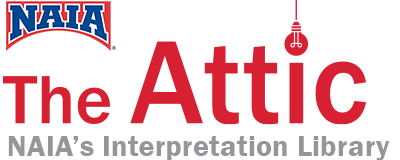-
USBC Transfer Portal & Direct Contact
Article II, Section D, addresses the protocol for contacting student-athletes regarding transfers between institutions. A coach or another representative of a member institution may initiate contact with a student whose most recent identification was at a non-NAIA four-year institution, but shall not initiate contact with a student-athlete whose most recent identification was at an NAIA…
-
Terms of Attendance & Eligibility with Mixed Terms
Academic Terms Conversion (Semesters/Quarters/Trimesters) Article V, Section F, Item 1: A student terminates athletic eligibility at the end of a term upon completing 10 semesters, 12 trimesters or 15 quarters in which the student is identified (See Article V, Section B, Item 8 of the NAIA Bylaws). Note that all terms (not hours) are converted…
-
NAIA Bylaws, Policies, and Sport Rules
NAIA members and student-athletes are held to many different types of rules and regulations. Understanding the different levels of NAIA rules will provide an understanding of the different regulations and, if a change is desired, how to go about requesting a change to the rules and regulations. Sport Rule Most NAIA championship sports have adopted…
-
Mid-Year Transfer Student Eligibility: Common Scenarios & FAQs
Transfer – No Season Charged in Previous Term Q: A transfer student currently attends an NAIA school for the fall term and was a member of the women’s basketball team. She intends to transfer to a new NAIA institution for the spring term. The student-athlete participated in 4 games during the fall term at the…
-
Outside Competitive Experience: 2023 Wrestling and Track & Field Bylaw
Bylaw Amendment Effective Date: May 1, 2023 as applied to eligibility decisions for NAIA competition in August 2023 or beyond. In the sports of indoor track and field, outdoor track and field and wrestling, a student-athlete’s participation in a competitive event shall count towards the student’s 20% threshold, regardless of whether the student-athlete officially represents…
-
Outside Competitive Experience Review – Update August 2023
OCE Review 2023 Update & Form: The Outside Competitive Experience form is used to determine if any outside competitive experience (OCE) should be charged if the student was not otherwise charged an intercollegiate SOC in the past 12 months. Under the section, “To whom this review does apply,” the first criteria in the section reads,…
-
Financial Aid Policy FAQs
The following questions are common FAQs we receive regarding how to apply the Council of Presidents Policy for Financial Aid Limits (Article XIII Institutional Financial Aid Policy). Reporting Emerging Sports/ Sports Not Sponsored Q1: We recently added women’s flag football to our list of NAIA sports, how should we report them? A: For Return on…
-
How to Certify After Post-Bacc Degree
After the bylaw amendment for Post-Baccalaureate eligibility, students now have the ability to seek either a graduate degree or a second undergraduate degree. The following informations provides guidance on how to certify student-athletes, specifically for the 24/36-Hour Rule, after the student has earned their first baccalaureate degree. Scenario 1: Student completed one term in graduate…
-
2023 Bylaw Update: Graduate Student Eligibility
Key Takeaways for Graduate Students’ Eligibility Frequently Asked Questions: Q: What is the reasoning behind distinguishing undergraduate eligibility and graduate eligibility like this? A: Early eligibility standards in the NAIA started with the philosophy that a student exhausted their eligibility when they earned their baccalaureate degree (in addition to the limits of 10 semesters/15 quarters…
-
Frequency of Play: Types of Competitions
Article I, Section H Frequency of Play defined as: The maximum number of varsity games, contests or playing dates an institution may schedule is listed below. The number of junior varsity or freshman games, contests or playing dates scheduled during the academic year cannot exceed the number of varsity games, contests or playing dates scheduled…
